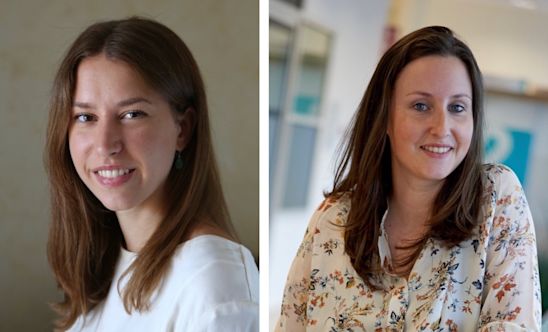Biomarker research
The EPND biomarker case studies: an interview with Marianna Rizzo and Stephanie Vos
09/05/2024

Our mission at EPND is to facilitate connection and multidisciplinary collaboration for the neurodegeneration research community in Europe and beyond. As we build our data and sample sharing platform, we are progressively testing the different platform components through the EPND case studies. As well as advancing the discovery and validation of neurodegeneration biomarkers, these case studies are helping us make sure that the EPND platform is efficient, effective and user-friendly. Learnings and data generated from EPND case studies will also be incorporated back into the platform to drive continued data access and innovation.
To learn more, we spoke to Stephanie Vos and Marianna Rizzo of Maastricht University. Together with EPND co-Lead, Pieter Jelle Visser, they play an instrumental role in the case studies, supporting interactions with the participating research cohorts and performing data harmonisation for cross-cohort analyses.
What are the EPND case studies, and what are they bringing to the project?
Stephanie: “As well as advancing biomarker research, the EPND case studies are helping us to road test the EPND platform as it develops. So far, four case studies have been initiated. We have also recently launched a Call for researchers to leverage samples and data catalogued in EPND - which is very exciting as the successful proposals will contribute towards a fifth EPND case study!
What is unique is that these four studies investigate several neurodegenerative diseases at once: Alzheimer’s Disease (AD), Parkinson’s Disease (PD) and Dementia with Lewy Bodies (DLB). Case study one focuses on the Amyloid-Tau-Neurodegeneration (ATN) biomarkers, which are widely used in AD. We are studying how CSF and plasma ATN biomarkers vary across neurodegenerative diseases, in particular AD, PD and DLB. Case Study two includes the same samples and focuses on the comparison between different complement assays and measurements of complement markers in these different neurodegenerative diseases. Case Study three investigates gut microbiome biomarkers in AD, PD, and DLB, using stool samples. Lastly in Case Study four, large-scale untargeted mass spectrometry proteomics is being performed on cerebrospinal fluid samples from AD, PD and DLB patients to identify disease subtypes and shared pathology. Through EPND, we are analysing samples on a large scale to answer these research questions and getting a better picture of similarities and differences across neurodegenerative diseases on a biomarker level.”
Work package 4 in EPND is all about cohort interactions. What does this work entail and how do you support the case studies and other EPND activities?
Stephanie: “Within work package 4, we have different disease area specialists for AD, PD and DLB. Rejko Kruger (University of Luxembourg) is an expert on the genetics of PD and is the disease area specialist for PD, with Sara Gomes. Dag Aarsland (King’s College London) leads a number of DLB cohorts and is the disease area specialist for DLB, with Olga Borejko. Pieter Jelle Visser, Marianna Rizzo and I are the disease area specialists for AD, also supporting engagement with cohorts focused on less prevalent neurodegenerative diseases. As a team, together with work package 4 co-lead Matt Clement (Gates Ventures), we are responsible for the communication with research cohorts, spanning twelve neurodegenerative disease areas. We’ve been heavily involved in onboarding cohorts to the EPND Catalogue, and we also support researchers to identify cohorts, samples and datasets of interest for their own research. Alongside, we provide input in other work packages, based on our expertise in the different disease areas.”
Could you tell us a bit about the work you did in case study 1, which was recently presented at the Alzheimer’s Association International Conference (AAIC)?
Marianna: “Traditionally, AD has been viewed as a clearly distinct disease from PD and DLB, with little overlap when it comes to symptoms or pathology. However, recent evidence suggests that the picture is more nuanced. As part of case study 1, we wanted to study the overlap in pathology between these three diseases, by comparing cerebrospinal fluid (CSF) biomarkers for ATN and alpha-synuclein in AD, PD and DLB. We also aimed to investigate the association of demographic, genetic and clinical factors with the presence of amyloid pathology in PD and DLB. To do this, we obtained samples and clinical data from 350 participants in different European research cohorts, which we harmonised in Maastricht for analysis.
Our results were very interesting. For example, while as expected participants with AD showed the lowest levels of amyloid, we also found that around 60% of participants with DLB, and 20% of participants with PD had amyloid pathology. A similar pattern emerged in the p-tau181 biomarker levels, and approximately 25% of participants with DLB and 10% of those with PD had tau pathology. Interestingly, we observed an association between p-tau181 and alpha-synuclein levels across the diseases. When we looked more closely at the influence of clinical factors on amyloid pathology, we found an association of amyloid pathology in DLB and PD with higher age, and with carriership of APOE-ε4, a genetic risk factor for AD.
This confirmed the existence of shared pathologies across people with different neurodegenerative diseases. Notably, we found that amyloid and tau pathology are common in DLB, and identified how these relate to other biomarkers and risk factors. Overall, this work has implications for the design of clinical trials - and potentially on how these biomarkers are used diagnostically in clinical practice.”
Data harmonisation was performed on the different clinical datasets used in case study one. Can you explain what data harmonisation is, and how it works?
Marianna: “Research cohorts often collect and annotate data in ways that are unique to them, using specific identifiers, measurement scales and descriptors. Data harmonisation is a crucial element for multi-cohort studies such as ours, because it merges data from different centres. The aim is to do it in the best possible way - losing as little information as possible.
Harmonisation starts with an assessment of how the data was collected and structured by the different centers. With this understanding, we can transform the data into a common format where all values for shared parameters are on the same scale and format. Harmonisation is often viewed as a purely technical process, but it also involves subject knowledge and many interactions with collaborators from the participating centers, who provide crucial information for our understanding of their datasets. This really underlines the importance of collaboration and sharing to maximise the value of research!”
Which cohorts were involved in your work and how did you interact with the different centres?
Stephanie: “The study described by Marianna involved seven different centres and 10 research cohorts, located in Switzerland, the Netherlands, Luxembourg, Germany, Norway and Czechia. Work package 4 played an important part in identifying cohorts of interest and coordinating the case study. For example, sample aliquoting, lab analysis and clinical data harmonisation all took place at different partners and therefore an important task for Work package 4 was to keep an overview of this process and to coordinate the logistics.
What is the value of cross-cohort collaboration and the support that EPND provides?
Marianna: “A major advantage of cross-cohort collaboration is increasing the number of research participants included and the richness of the data - for example, by bringing together a unique and well-characterised cohort of three different neurodegenerative diseases. EPND makes this collaboration possible, which is hugely beneficial for researchers like myself.”
Stephanie: “I agree with Marianna: bringing more samples and data together makes it possible to detect smaller differences between groups. A good example for this is the proteomics analysis we are doing in AD, PD, and DLB. By combining data and samples of 1000 cases across cohorts, we can better understand what is happening in the different diseases. Thanks to the support provided by EPND, we have now the power to look across these different diseases and to see how they overlap – but also how they are distinct.”
Many thanks to Stephanie, Marianna and collaborators for all their work in EPND!

